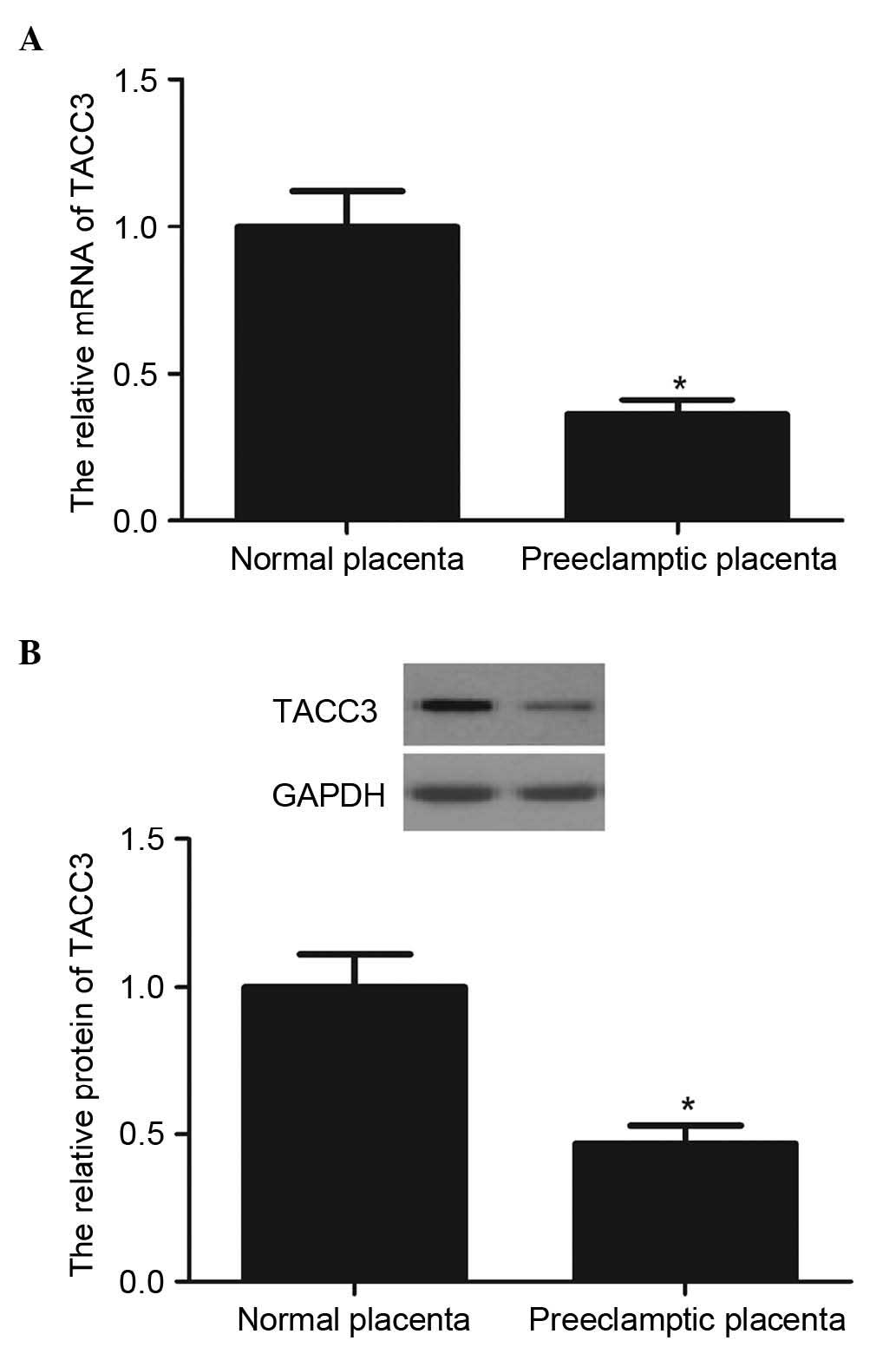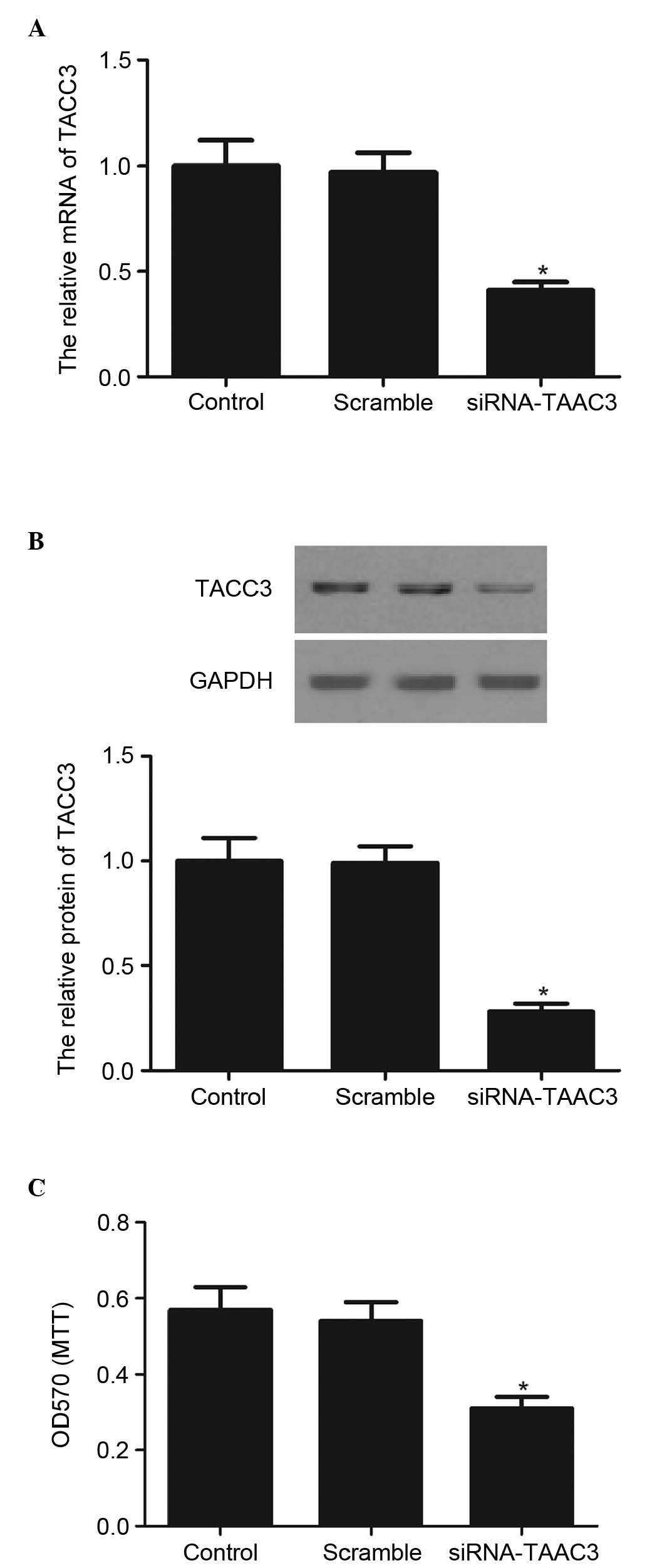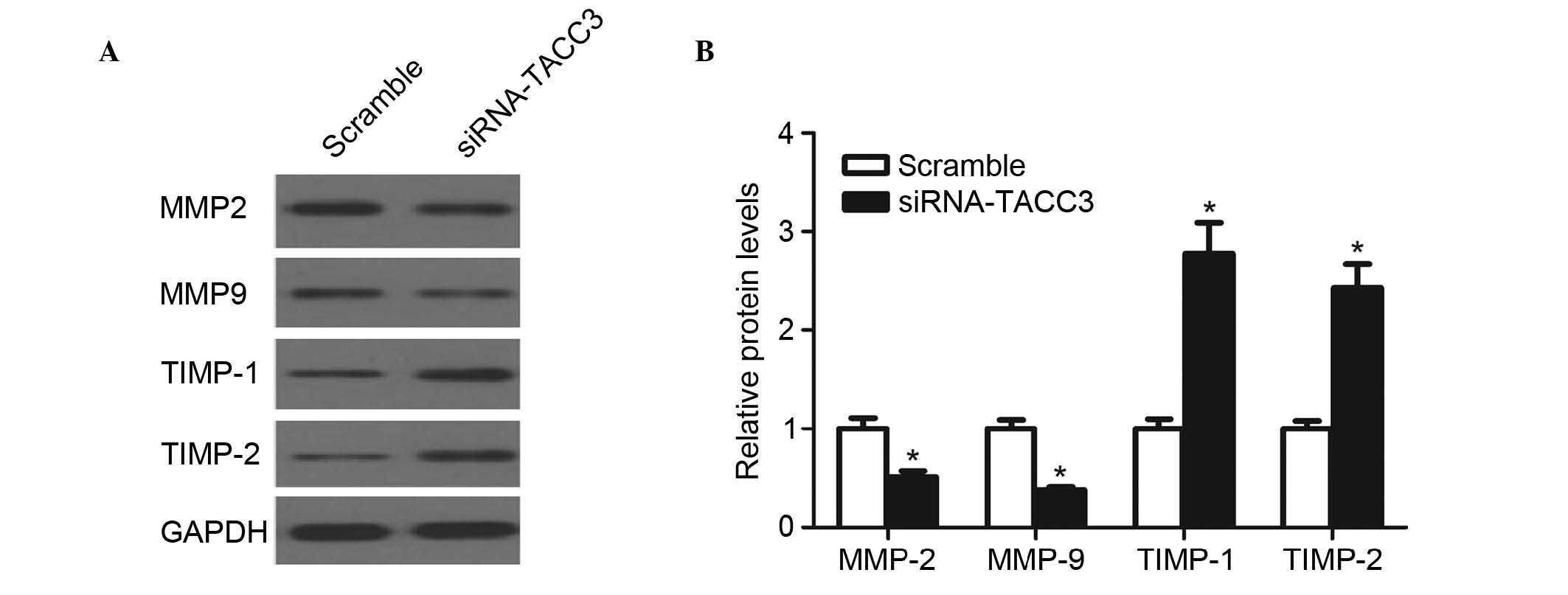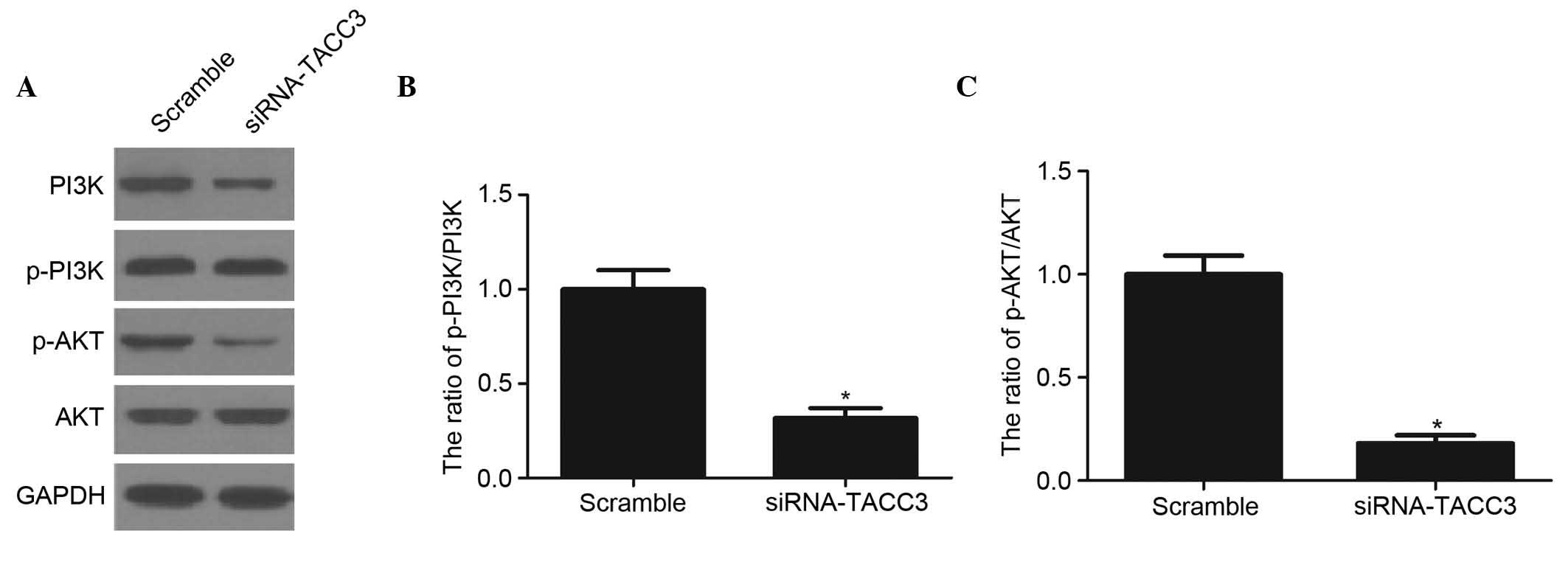Knockdown of TACC3 inhibits trophoblast cell migration and invasion through the PI3K/Akt signaling pathway
- Authors:
- Published online on: August 19, 2016 https://doi.org/10.3892/mmr.2016.5659
- Pages: 3437-3442
Abstract
Introduction
Preeclampsia is a major disorder of pregnancy and a leading contributor to maternal and perinatal morbidity and mortality rates (1). Although reduced trophoblast proliferation, aberrant trophoblast differentiation, limited migration and invasion of trophoblasts in the uterus, poor remodeling of spiral arteries, and excessive apoptosis have been associated with preeclampsia (2–5), the molecular mechanisms underlying the onset and progression of preeclampsia remain to be fully elucidated, therefore, it is important to investigate these molecular mechanisms of preeclampsia.
The transforming acidic coiled-coil protein (TACC) family is characterized by a conserved C-terminal 'TACC domain' (6). In mammals, three TACC proteins are expressed from three genes, TACC1, TACC2 (also known as AZU-1 and ECTACC) and TACC3 (also known as AINT and ERIC1) (7). During mitosis, the TACC proteins localize around the centrosomes and are important for the organization of microtubule organizing centers (8). TACC3, a member of the TACC domain family, was first identified as a microtubule-binding protein (9). It has been reported that the depletion of TACC3 causes growth retardation and embryonic mortality in mice due to increased apoptosis (10); and TACC3 promotes axon elongation and regulates microtubule plus end dynamics in multiple embryonic cell types (11). In addition, several studies have demonstrated that TACC3 can promote cell proliferation, metastasis and invasion, and regulate cell cycle progression and differentiation in a variety of cancer cells (12–14). However, the role of TACC3 in trophoblast function during placental development remains to be fully elucidated. The present study aimed to determine the expression and function of TACC3 in human placentas and to examine the underlying mechanisms. The results demonstrated that TACC3 induced trophoblast cell growth, migration and invasion by activation of the phosphoinositide 3-kinase (PI3K)/Akt signaling pathway. TACC3 may serve as a novel potential target in the treatment of preeclampsia.
Materials and methods
Tissue specimens
Human placental tissues at 6–8 weeks were obtained from 10 healthy women undergoing cesarean section for non-medical reasons; normal term and preeclamptic placentas were collected following cesarean section. The fresh tissue specimens were immediately snap-frozen and stored in liquid nitrogen until use. The protocol for the use of patient samples was approved by the Ethics Committee of the School of Medicine, Zhejiang University (Zhejiang, China) and written informed consent was obtained from each patient.
Cell culture
The immortalized first trimester trophoblast cell line, HTR8/SVneo, was obtained from American Type Culture Collection (Manassas, VA, USA). The cells were cultured in RPMI 1640 medium (Invitrogen; Thermo Fisher Scientific, Inc., Waltham, MA, USA) supplemented with 100 U/ml penicillin and 100 mg/ml streptomycin (Sigma-Aldrich; Thermo Fisher Scientific, Inc.) in the presence of 10% fetal bovine serum (Sigma-Aldrich; Thermo Fisher Scientific, Inc.). The cells were cultured at 37°C in a 5% CO2 incubator.
Small interfering (si)RNA knockdown of TACC3
The siRNA against TACC3 (siRNA-TACC3) and the control (scramble) were purchased from Santa Cruz Biotechnology, Inc. (Santa Cruz, CA, USA). The HTR8/SVneo cells were transfected with either siRNA-TACC3 or scramble siRNA using Lipofectamine™ 2000 (Invitrogen; Thermo Fisher Scientific, Inc.), according to the manufacturer's protocols.
RNA extraction and reverse transcription-quantitative polymerase chain reaction (RT-qPCR) analysis
Total RNA was extracted from the HTR8/SVneo cells using TRIzol reagent (Abcam, Cambridge, UK) according to the manufacturer's protocol. cDNA was synthesized from the extracted RNA (4 µg) using the EasyScript First-Strand cDNA Synthesis SuperMix kit (Invitrogen; Thermo Fisher Scientific, Inc.). The RT-qPCR was performed in a final volume of 10 µl, containing 5 µl of SsoFast™ EvaGreen Supermix (Bio-Rad Laboratories, Inc., Hercules, CA, USA), 1 µl cDNA (1:50 dilution), and 2 µl each of the forward and reverse primers (1 mM) with a Bio-Rad iQ5 Quantitative PCR System (Bio-Rad Laboratories, Inc.). PCR amplification was performed using the following primers: TACC3, forward 5′-GAACTGGGGAAGATCATGGA-3′ and reverse 5′-CTCTTCGTTCTTGCGGTAGC-3′; and β-actin, forward 5′-TTAGTTGCGTTACACCCTTTC-3′ and reverse 5′-ACCTTCACCGTTCCAGTTT-3′. The PCR conditions consisted of an initial preincubation step at 95°C for 30 sec, followed by 39 cycles at 95°C for 5 sec and 60°C for 30 min. The relative mRNA levels were calculated using the 2−ΔΔCq method (15).
Western blot analysis
Cell lysate was prepared from the HTR8/SVneo cells using lysis buffer (Cell Signaling Technology, Inc., Danvers, MA, USA). Proteins were separated by centrifugation at 6,000 × g for 15 min at 4°C and the supernatant was collected. Protein concentration was determined by the bicinchoninic acid assay. The proteins (20–30 µg per lane) were separated by 10% SDS-PAGE and transferred onto a nitrocellulose membrane (EMD Millipore, Boston, MA, USA). The membranes were blocked with 5% fat-free milk in phosphate-buffered saline with Tween 20 (PBST) at room temperature for 1 h, followed by incubation with primary antibodies (all from Santa Cruz Biotechnology, Inc.) overnight at 4°C. The primary antibodies were as follows: Mouse monoclonal anti-TACC3 (1:3,000; cat. no. sc-376883), mouse monoclonal anti-matrix metalloproteinase-2 (MMP-2; 1:1,000; cat. no. sc-13594), mouse monoclonal anti-MMP-9 (1:2,500; cat. no. 21733), mouse monoclonal anti-tissue inhibitor of metalloproteinase 1 (TIMP1; 1:1,500; cat. no. sc-365905), mouse monoclonal anti-TIMP2 (1:1,500; cat. no. 21735), rabbit polyclonal anti-phosphorylated PI3K (1:2,000; cat. no. 293115), mouse monoclonal anti-PI3K (1:2,000; cat. no. 365290), rabbit polyclonal anti-phosphorylated Akt (1:2,000; sc-135650), mouse monoclonal anti-Akt (1:2,000; cat. no. sc-5298) or mouse monoclonal anti-GAPDH (1:1,500; cat. no. sc-365062). The membrane was washed five times with PBST buffer. Goat anti-mouse (1:3,000; cat. no. sc-2302) and goat anti-rabbit (1:3,000; cat. no. sc-2054) horseradish peroxidase-conjugated secondary antibodies were added and incubated at room temperature for 1 h. The protein bands were evaluated using enhanced chemiluminescence (Thermo Fisher Scientific, Inc.).
Cell proliferation assay
The HTR8/SVneo cells were plated in 96-well plates at a density of ~1×104 cells/well. The cells were transfected with siRNA-TACC3 or scramble. Following incubation for 24 h at 37°C, 20 ml of 5 mg/ml 3-[4,5-dimethylthiazol-2-yl]-2,5-diphenyl tetrazolium bromide (MTT; Sigma-Aldrich; Thermo Fisher Scientific, Inc.) was added to the medium and incubated for 4 h at 37°C. The formazan was dissolved in dimethylsulfoxide (150 µl/well; Sigma-Aldrich; Thermo Fisher Scientific, Inc.) for 10 min. The absorbance was measured at 570 nm.
Matrigel invasion assay and Transwell migration assay
Cell invasion was determined by the ability of the cells to cross the 8-mm pores of polycarbonate membranes (6.5-mm filter; 8-mm pore size; Corning Costar, Inc., Corning, NY, USA). In brief, the HTR8/SVneo cells (1.0×105 cells/well) transfected with siRNA-TACC3 or scramble were plated in the upper chambers, and 600 µl of RPMI-1640 medium containing 10% fetal bovine serum was added to the lower chamber. Following incubation for 24 h under normal conditions, the cells on the upper surface of the base membrane were removed with a sterile cotton swab. The cells, which had transferred to the lower surface of the base membrane were stained with hematoxylin and eosin (Sigma-Aldrich; Thermo Fisher Scientific, Inc.) and the numbers of cells were counted under a Leica microscope (Leica Microsystems GmbH, Wetzlar, Germany). The methods utilized in the Transwell migration assays were similar to those used in the cell invasion assays, with the exception that the inserts were not pre-coated with Matrigel.
Statistical analysis
Data are presented as the mean ± standard deviation. The differences were analyzed using Student's t-test or one-way analysis of variance and Student's t-test using SPSS 13.0 (SPSS, Inc., Chicago, IL, USA). P<0.05 was considered to indicate a statistically significant difference.
Results
Expression of TACC3 is decreased in preeclamptic placentas
The present study first detected the mRNA levels of TACC3 in the preeclamptic placentas using RT-qPCR. As shown in Fig. 1A, the mRNA levels of TACC3 in the preeclamptic placentas were markedly lower, compared with those in the normal placentas. Western blot analysis showed that the protein levels of TACC3 were also significantly lower in the preeclampsia placentas, compared with the control group (Fig. 1B). These results suggested that the expression of TACC3 was reduced in preeclamptic placentas.
Silencing TACC3 significantly inhibits the proliferation of HTR8/SVneo cells
To examine the functional roles of TACC3 in the human placenta, HTR8/SVneo cells were transfected with siRNA-TACC3 or scramble. As shown in Fig. 2A, the mRNA expression of TACC3 was significantly decreased in the HTR8/SVneo cells transfected with siRNA-TACC3, compared with the scramble group. The knockdown of TACC3 also reduced the protein expression of TACC3 (Fig. 2B). An MTT assay was then used to measure the effect of TACC3 on HTR8/SVneo cell proliferation. As shown in Fig. 2C, knockdown of TACC3 significantly inhibited the proliferation of the HTR8/SVneo cells, compared with the scramble group.
Silencing TACC3 significantly inhibits the migration and invasion of HTR8/SVneo cells
The migration and invasion of trophoblast cells is important in the process of preeclampsia. Therefore, the present study investigated the effect of TACC3 on HTR8/SVneo cell migration and invasion. As shown in Fig. 3, compared with the scramble group, knockdown of TACC3 significantly decreased the percentage of cells that migrated (Fig. 3A) or invaded (Fig. 3B) to the other side of the filter.
Silencing TACC3 reduces the expression of MMP2/9 and increases the expression of TIMP1/2 in HTR8/SVneo cells
It has been reported that MMP2 and MMP9 are critical in trophoblast invasion by degrading the extracellular matrix (ECM) (16). Therefore, the present study determined the effect of TACC3 on the expression of MMPs in HTR8/SVneo cells. As shown in Fig. 4A and B, compared with the scramble group, knockdown of TACC3 significantly reduced the expression levels of MMP2 and MMP9. By contrast, the knockdown of TACC3 significantly increased the expression levels of TIMP1 and TIMP2 in the HTR8/SVneo cells.
Silencing TACC3 reduces the phosphorylation levels of PI3K and Akt
The PI3K/Akt pathway is one of the major signaling pathways associated with trophoblast invasion (17). To examine the involvement of the signaling pathway in TACC3-induced HTR8/SVneo cell invasion, the present study evaluated the effects of TACC3 on the PI3K/Akt signaling pathway. As shown in Fig. 5A–C), compared with the scramble group, the knockdown of TACC3 significantly reduced the levels of phosphorylated PI3K and Akt in the HTR8/SVneo cells.
Discussion
The present study is the first, to the best of our knowledge, to demonstrate the expression and function of TACC3 in human early placental tissues. The results showed that the expression of TACC3 was downregulated in preeclamptic placentas, compared with normal placentas. The knockdown of TACC3 significantly inhibited HTR8/SVneo cell proliferation, migration and invasion, and inhibited the expression of MMPs. In addition, the knockdown of TACC3 significantly reduced the levels of phosphorylated PI3K and Akt in the HTR8/SVneo cells.
Trophoblast cells have high rates of cell proliferation, lack cell-contact inhibition, and are able to evade effectors of the immune system, particularly during the first trimester of pregnancy (18). For trophoblast cells, invasion can ensure that agents can enter the uterine stroma and gain access to the maternal circulation. Increasing evidence indicates that the deficient migration and shallow invasion of trophoblasts may lead to preeclampsia (19–21). In addition, the invasion/migration properties and the regulatory mechanisms are similar between trophoblasts and malignant cells (22). In the present study, the expression and role of TACC3 in the progression of preeclampsia were investigated, and it was observed that knockdown of TACC3 significantly inhibited HTR8/SVneo cell proliferation, migration and invasion. These results are consistent with the previously reported role of TACC3 in human malignancies (13), and suggest that TACC3 may be important in the progression of preeclampsia.
MMPs are a family of zinc-dependent endopeptidases involved in the degradation of the majority of the proteins of the ECM (23). Previous studies have reported that MMPs are important in the process of trophoblast invasion (16,24,25). It has also been reported that MMP-2 is predominantly expressed in extravillous trophoblasts in the placenta during the first trimester (26). In addition, TIMPs have the ability to inhibit the activity of MMPs in the extracellular space by binding specifically to active MMPs (27). In the present study, it was observed that knockdown of TACC3 significantly inhibited the expression of MMP-2 and MMP-9, and increased the expression of TIMP1/2. These results suggested that siRNA-TACC3 may contribute to the downregulation of the expression of MMP-2 and MMP-9, which may lead to reduced HTR8/SVneo cell migration and invasion.
Multiple signals have been demonstrated to be important in trophoblast growth and invasion (28–30). Among these, the PI3K/Akt signaling pathway is a critical pathway mediating the growth-factor-dependent regulation of trophoblast growth and invasion (31). Ha et al (14) reported that TACC3 promotes epithelial-mesenchymal transition through activation of the PI3K/Akt and extracellular signal-regulated kinase signaling pathways in tumor cells (14). To further clarify the underlying mechanism involved in TACC3-inhibited HTR8/SVneo cell growth and invasion, the present study examined the levels of phosphorylated PI3K and Akt following siRNA-TACC3 transfection. It was observed that the knockdown of TACC3 significantly reduced the levels of phosphorylated PI3K and Akt in the HTR8/SVneo cells. These results suggested that siRNA-TACC3 inhibited the invasion and downregulated the expression levels of MMPs in the HTR8/SVneo cells through suppression of the PI3K/Akt signaling pathway.
Taken together, the results of the present study demonstrated that the knockdown of TACC3 inhibited the migration and invasion of HTR8/SVneo cells through suppression of the PI3K/Akt signaling pathway. Therefore, TACC3 may serve as a novel potential target in the treatment of preeclampsia.
References
|
Kanasaki K and Kalluri R: The biology of preeclampsia. Kidney Int. 76:831–837. 2009. View Article : Google Scholar : PubMed/NCBI | |
|
Redline RW and Patterson P: Pre-eclampsia is associated with an excess of proliferative immature intermediate trophoblast. Hum Pathol. 26:594–600. 1995. View Article : Google Scholar : PubMed/NCBI | |
|
Fisher SJ: The placental problem: Linking abnormal cytotrophoblast differentiation to the maternal symptoms of preeclampsia. Reprod Biol Endocrinol. 2:532004. View Article : Google Scholar : PubMed/NCBI | |
|
Cui Y, Wang W, Dong N, Lou J, Srinivasan DK, Cheng W, Huang X, Liu M, Fang C, Peng J, et al: Role of corin in trophoblast invasion and uterine spiral artery remodelling in pregnancy. Nature. 484:246–250. 2012. View Article : Google Scholar : PubMed/NCBI | |
|
Myatt L: Role of placenta in preeclampsia. Endocrine. 19:103–111. 2002. View Article : Google Scholar | |
|
O'Brien LL, Albee AJ, Liu L, Tao W, Dobrzyn P, Lizarraga SB and Wiese C: The Xenopus TACC homologue, maskin, functions in mitotic spindle assembly. Mol Biol Cell. 16:2836–2847. 2005. View Article : Google Scholar : PubMed/NCBI | |
|
Peset I and Vernos I: The TACC proteins: TACC-ling microtubule dynamics and centrosome function. Trends Cell Biol. 18:379–388. 2008. View Article : Google Scholar : PubMed/NCBI | |
|
Gergely F, Karlsson C, Still I, Cowell J, Kilmartin J and Raff JW: The TACC domain identifies a family of centrosomal proteins that can interact with microtubules. Proc Natl Acad Sci USA. 97:14352–14357. 2000. View Article : Google Scholar : PubMed/NCBI | |
|
Groisman I, Huang YS, Mendez R, Cao Q, Theurkauf W and Richter JD: CPEB, maskin, and cyclin B1 mRNA at the mitotic apparatus: Implications for local translational control of cell division. Cell. 103:435–447. 2000. View Article : Google Scholar : PubMed/NCBI | |
|
Piekorz RP, Hoffmeyer A, Duntsch CD, McKay C, Nakajima H, Sexl V, Snyder L, Rehg J and Ihle JN: The centrosomal protein TACC3 is essential for hematopoietic stem cell function and genetically interfaces with p53-regulated apoptosis. EMBO J. 21:653–664. 2002. View Article : Google Scholar : PubMed/NCBI | |
|
Nwagbara BU, Faris AE, Bearce EA, Erdogan B, Ebbert PT, Evans MF, Rutherford EL, Enzenbacher TB and Lowery LA: TACC3 is a microtubule plus end-tracking protein that promotes axon elongation and also regulates microtubule plus end dynamics in multiple embryonic cell types. Mol Biol Cell. 25:3350–3362. 2014. View Article : Google Scholar : PubMed/NCBI | |
|
Huang ZL, Lin ZR, Xiao YR, Cao X, Zhu LC, Zeng MS, Zhong Q and Wen ZS: High expression of TACC3 in esophageal squamous cell carcinoma correlates with poor prognosis. Oncotarget. 6:6850–6861. 2015. View Article : Google Scholar : PubMed/NCBI | |
|
Ha GH, Kim JL and Breuer EK: TACC3 is essential for EGF-mediated EMT in cervical cancer. PLoS One. 8:e703532013. View Article : Google Scholar : PubMed/NCBI | |
|
Ha GH, Park JS and Breuer EK: TACC3 promotes epithelial-mesenchymal transition (EMT) through the activation of PI3K/Akt and ERK signaling pathways. Cancer Lett. 332:63–73. 2013. View Article : Google Scholar : PubMed/NCBI | |
|
Livak KJ and Schmittgen TD: Analysis of relative gene expression data using real-time quantitative PCR and the 2(-Delta Delta C(T)) method. Methods. 25:402–408. 2001. View Article : Google Scholar | |
|
Cohen M, Meisser A and Bischof P: Metalloproteinases and human placental invasiveness. Placenta. 27:783–793. 2006. View Article : Google Scholar | |
|
Qiu Q, Yang M, Tsang BK and Gruslin A: Both mitogen-activated protein kinase and phosphatidylinositol 3-kinase signalling are required in epidermal growth factor-induced human trophoblast migration. Mol Hum Reprod. 10:677–684. 2004. View Article : Google Scholar : PubMed/NCBI | |
|
Ferretti C, Bruni L, Dangles-Marie V, Pecking A and Bellet D: Molecular circuits shared by placental and cancer cells and their implications in the proliferative, invasive and migratory capacities of trophoblasts. Hum Reprod Update. 13:121–141. 2007. View Article : Google Scholar | |
|
Kaufmann P, Black S and Huppertz B: Endovascular trophoblast invasion: Implications for the pathogenesis of intrauterine growth retardation and preeclampsia. Biol Reprod. 69:1–7. 2003. View Article : Google Scholar : PubMed/NCBI | |
|
Davison JM, Homuth V, Jeyabalan A, Conrad KP, Karumanchi SA, Quaggin S, Dechend R and Luft FC: New aspects in the pathophysiology of preeclampsia. J Am Soc Nephrol. 15:2440–2448. 2004. View Article : Google Scholar : PubMed/NCBI | |
|
Pijnenborg R, Vercruysse L and Hanssens M: Fetal-maternal conflict, trophoblast invasion, preeclampsia, and the red queen. Hypertens Pregnancy. 27:183–196. 2008. View Article : Google Scholar : PubMed/NCBI | |
|
Mullen CA: Review: Analogies between trophoblastic and malignant cells. Am J Reprod Immunol. 39:41–49. 1998. View Article : Google Scholar : PubMed/NCBI | |
|
Westermarck J and Kähäri VM: Regulation of matrix metalloproteinase expression in tumor invasion. FASEB J. 13:781–792. 1999.PubMed/NCBI | |
|
Staun-Ram E, Goldman S, Gabarin D and Shalev E: Expression and importance of matrix metalloproteinase 2 and 9 (MMP-2 and -9) in human trophoblast invasion. Reprod Biol Endocrinol. 2:592004. View Article : Google Scholar : PubMed/NCBI | |
|
Hulboy DL, Rudolph LA and Matrisian LM: Matrix metalloproteinases as mediators of reproductive function. Mol Hum Reprod. 3:27–45. 1997. View Article : Google Scholar : PubMed/NCBI | |
|
Isaka K, Usuda S, Ito H, Sagawa Y, Nakamura H, Nishi H, Suzuki Y, Li Y and Takayama M: Expression and activity of matrix metalloproteinase 2 and 9 in human trophoblasts. Placenta. 24:53–64. 2003. View Article : Google Scholar | |
|
Nagase H, Visse R and Murphy G: Structure and function of matrix metalloproteinases and TIMPs. Cardiovasc Res. 69:562–573. 2006. View Article : Google Scholar : PubMed/NCBI | |
|
Prast J, Saleh L, Husslein H, Sonderegger S, Helmer H and Knöfler M: Human chorionic gonadotropin stimulates trophoblast invasion through extracellularly regulated kinase and AKT signaling. Endocrinology. 149:979–987. 2008. View Article : Google Scholar | |
|
Chakraborty C, Gleeson LM, McKinnon T and Lala PK: Regulation of human trophoblast migration and invasiveness. Can J Physiol Pharmacol. 80:116–124. 2002. View Article : Google Scholar : PubMed/NCBI | |
|
Fitzgerald JS, Poehlmann TG, Schleussner E and Markert UR: Trophoblast invasion: The role of intracellular cytokine signalling via signal transducer and activator of transcription 3 (STAT3). Hum Reprod Update. 14:335–344. 2008. View Article : Google Scholar : PubMed/NCBI | |
|
Knöfler M and Pollheimer J: IFPA Award in Placentology lecture: Molecular regulation of human trophoblast invasion. Placenta. 33(Suppl): S55–S62. 2012. View Article : Google Scholar : |














